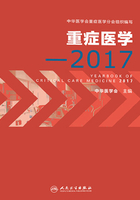
上QQ阅读APP看书,第一时间看更新
3 ARDS机械通气策略:关注右心保护
急性呼吸窘迫综合征(acute respiratory distress syndrome,ARDS)时通过缺氧性肺血管收缩、血管收缩因子释放、间质水肿压迫血管、血管重塑及血栓栓塞等病理生理机制,可导致肺血管阻力(pulmonary vascular resistance,PVR)升高,肺动脉高压,右心后负荷增加,最终导致右心衰 [1]。多项研究 [2,3]显示,约20%~25%的ARDS患者合并急性肺心病(acute cor pulmonale,ACP)。
作为ARDS治疗的关键措施,机械通气的目的在于复张塌陷肺泡,增加功能残气量,纠正低氧血症,降低PVR,改善右心后负荷及血流动力学。然而,正压通气时跨肺压即肺的膨胀压增加,可对肺泡毛细血管产生挤压,导致PVR升高,进而增加右心后负荷,甚至可出现急性肺动脉高压及右心室功能障碍。因此,ARDS行机械通气时,不能只关注氧合的改善,还需采取右心保护策略 [4]。该策略主要包括三个要素:通过限制平台压和驱动压降低肺应力,改善氧合以逆转缺氧性肺血管收缩,减轻高碳酸血症。但在最危重的患者中,以上目标之间可能存在矛盾,而采取俯卧位可能为有效措施 [5]。
一、降低肺应力
机械通气导致的肺应力,取决于PEEP、潮气量以及肺的顺应性。没有证据表明哪种通气模式对肺血管血流动力学的影响更大。任何通气模式对PVR的影响,都可能与PEEP和平台压相关。应调整潮气量及PEEP以保持平台压<27cmH 2O以及驱动压<15cmH 2O [6]。应用经食管超声发现,正压通气对右室功能的影响与潮气量直接相关。降低潮气量可以降低肺应力。所以小潮气量通气,尤其以跨肺压导向的小潮气量设置可能更为合理。但最佳PEEP的选择仍有争议,PEEP在吸气和呼气时均增加右室负荷,引起ARDS患者右室流出道阻力增加 [7]。Suter等 [8]从最佳顺应性等角度考虑,认为能使PaO 2/FiO 2值最佳而不降低呼吸系统顺应性甚或能改善顺应性的PEEP,可能即为最佳PEEP,其值接近于7~8cmH 2O。此时PEEP可在肺复张和过度膨胀之间取得较好的平衡,改善肺复张,且不损害右心室功能。Jardin等 [9]研究也显示,当PEEP增加至10cmH 2O以上时,则会出现与右室收缩期超负荷相关的进行性心输出量下降、平均动脉压降低以及左室扩张度减少。PEEP值越高,右室后负荷增加越明显,右室射血就越少。应用PEEP不仅增加呼气末跨肺压,潮气量调节不当也会增加吸气末跨肺压,从而严重影响肺循环。如果PEEP主要引起的是塌陷肺组织复张,使肺顺应性得到了改善,则跨肺压的增加就不明显,对右心室的影响也较小;但是如果PEEP主要引起肺过度充气,则跨肺压的增加幅度较大,对右室的影响也将很明显。PEEP值的改变将引起右心室功能相应变化,通过观察该变化能找出肺复张至肺过度充气之间的平衡点 [10]。
二、改善缺氧性肺血管收缩
低氧可引起肺血管收缩,导致肺血管重塑,即非肌化肺小动脉及远端动脉发生肌化,引起肺动脉高压及右心室功能障碍 [10]。研究显示,当健康志愿者存在缺氧时(PO 2<50mmHg),肺血管收缩可导致PVR增加至基础的100%至150% [11]。Marshall等 [12]研究显示,吸入氧气浓度为100%时,ARDS时的缺氧性肺血管收缩迅速缓解,肺动脉压力可自峰值下降10%到15%。因此,纠正低氧血症,改善缺氧性肺血管收缩是ARDS治疗不可或缺的部分。
三、减轻高碳酸血症
在ARDS患者,高碳酸血症首先是由于疾病本身导致肺组织受损所致,其次与机械通气参数设置有关,即为了保证安全的平台压而限制潮气量,可导致肺泡无效腔减少,造成高碳酸血症。高碳酸血症通过诱导肺循环血管收缩可引起右心室功能障碍。
ARDS治疗过程中应保持PaCO 2<48mmHg,即允许性高碳酸血症。而呼吸频率过快,则可能诱导内源性PEEP和动态的过度膨胀,从而不利于CO 2的清除并损害右心室功能 [13]。所以,机械通气时应抑制患者强烈的自主呼吸 [14],避免人机对抗对肺循环及右心室功能所导致的损害,并注意严密监测总PEEP [15]。另外,推荐使用加热湿化器,减少仪器无效腔,但不宜使用人工鼻 [16]。
对某些患者,高碳酸血症难以通过传统的方法改善,可尝试体外CO 2清除 [17]。在ARDS合并酸中毒的实验模型中,Morimont等 [18]研究显示静脉-静脉CO 2 清除治疗可通过降低肺动脉压及改善右心功能使PaCO 2降至正常。但尚需临床研究进一步证实。
四、俯卧位通气
肺不张、肺泡过度膨胀都可导致PVR升高。但ARDS时肺的通气并不均一,塌陷区和通气正常区域共同存在。另外,肺复张的床边简易评估难以实现,且患者之间变异度大。所以,高PEEP可使塌陷区域复张,但同时可导致正常通气区域过度膨胀,从而影响右心室功能[5,19]。
俯卧位通气可诱导肺泡复张而不导致过度膨胀,从而同时保护肺和右心室。其机制如下:第一,俯卧位可减轻肺部炎症,甚至全身炎症反应,从而改善因细胞因子释放导致的心功能损害。第二,俯卧位可降低右心室后负荷,纠正右心衰。这可能与俯卧位通气改善氧合且不需要明显增加PEEP有关,通过使肺通气更均一以降低PaCO 2,通过重力依赖区的背区肺复张以降低驱动压 [20]。因此,对于极为严重ARDS患者,机械通气24~48小时后氧合指数仍低于100mmHg并合并严重ACP患者,“右心室保护性通气策略”必须考虑联合俯卧位通气,以增加肺顺应性、降低平台压和PaCO 2水平,促进氧合改善,从而有利于保护右心室功能 [21]。
综上所述,鉴于右心衰竭是ARDS的独立危险因素,对ARDS实施机械通气时,临床医生不应忽略血流动力学及右心功能,应牢记肺和右心系统是密切关联的。临床工作中应全面了解气道正压对肺循环和右心室功能的影响,常规采用超声心动图动态评估右心室功能,采取“右心室保护性通气策略”控制平台压,改善氧合,控制高碳酸血症,从而降低PVR,保护右心功能。对严重ARDS患者,该通气方法应联合俯卧位通气治疗。
(郑瑞强 吕清泉)
参考文献
1.Price LC,McAuley DF,Marino PS,et al.Pathophysiology of pulmonary hypertension in acute lung injury.American journal of physiology Lung cellular and molecular physiology,2012,302(9):L803-815.
2.Lheritier G,Legras A,Caille A,et al.Prevalence and prognostic value of acute cor pulmonale and patent foramen ovale in ventilated patients with early acute respiratory distress syndrome:a multicenter study.Intensive Care Medicine,2013,39(10):1734-1742.
3.Vieillard-Baron A,Schmitt JM,Augarde R,et al.Acute cor pulmonale in acute respiratory distress syndrome submitted to protective ventilation:incidence,clinical implications,and prognosis.Critical Care Medicine,2001,29(8):1551-1555.
4.Ferguson ND,Fan E,Camporota L,et al.The Berlin definition of ARDS:an expanded rationale,justification,and supplementary material.Intensive Care Medicine,2012,38(10):1573-1582.
5.Paternot A,Repesse X,Vieillard-Baron A.Rationale and Description of Right Ventricle-Protective Ventilation in ARDS.Respiratory Care,2016,61(10):1391-1396.
6.Ryan D,Frohlich S,McLoughlin P.Pulmonary vascular dysfunction in ARDS.Annals of Intensive Care,2014,4:28.
7.Schmitt JM,Vieillard-Baron A,Augarde R,et al.Positive end-expiratory pressure titration in acute respiratory distress syndrome patients:impact on right ventricular outflow impedance evaluated by pulmonary artery Doppler flow velocity measurements.Critical Care Medicine,2001,29(6):1154-1158.
8.Suter PM,Fairley B,Isenberg MD.Optimum end-expiratory airway pressure in patients with acute pulmonary failure.The New England Journal of Medicine,1975,292(6):284-289.
9.Jardin F,Farcot JC,Boisante L,et al.Influence of positive end-expiratory pressure on left ventricular performance.The New England Journal of Medicine,1981,304(7):387-392.
10.Bouferrache K,Vieillard-Baron A.Acute respiratory distress syndrome,mechanical ventilation,and right ventricular function.Current Opinion in Critical Care,2011,17(1):30-35.
11.Dorrington KL,Clar C,Young JD,et al.Time course of the human pulmonary vascular response to 8 hours of isocapnic hypoxia.The American journal of physiology,1997,273(3 Pt 2):H1126-1134.
12.Marshall BE,Hanson CW,Frasch F,et al.Role of hypoxic pulmonary vasoconstriction in pulmonary gas exchange and blood flow distribution.2.Pathophysiology.Intensive care medicine,1994,20(5):379-389.
13.Vieillard-Baron A,Prin S,Augarde R,et al.Increasing respiratory rate to improve CO 2 clearance during mechanical ventilation is not a panacea in acute respiratory failure.Critical Care Medicine,2002,30(7):1407-1412.
14.Dreyfuss D,Soler P,Basset G,et al.High inflation pressure pulmonary edema.Respective effects of high airway pressure,high tidal volume,and positive end-expiratory pressure.The American Review of Respiratory Disease,1988,137(5):1159-1164.
15.Tabuchi A,Nickles HT,Kim M,et al.Acute Lung Injury Causes Asynchronous Alveolar Ventilation That Can Be Corrected by Individual Sighs.American Journal of Respiratory and Critical Care Medicine,2016,193(4):396-406.
16.Prin S,Chergui K,Augarde R,et al.Ability and safety of a heated humidifier to control hypercapnic acidosis in severe ARDS.Intensive Care Medicine,2002,28(12):1756-1760.
17.Vieillard-Baron A,Matthay M,Teboul JL,et al.Experts’ opinion on management of hemodynamics in ARDS patients:focus on the effects of mechanical ventilation.Intensive Care Medicine,2016,42(5):739-749.
18.Morimont P,Guiot J,Desaive T,et al.Veno-venous extracorporeal CO 2 removal improves pulmonary hemodynamics in a porcine ARDS model.Acta anaesthesiologica Scandinavica,2015,59(4):448-456.
19.Vieillard-Baron A,Price LC,Matthay MA.Acute cor pulmonale in ARDS.Intensive Care Medicine,2013,39(10):1836-1838.
20.Jozwiak M,Teboul JL,Anguel N,et al.Beneficial hemodynamic effects of prone positioning in patients with acute respiratory distress syndrome.American Journal of Respiratory and Critical Care Medicine,2013,188(12):1428-1433.
21.Vieillard-Baron A,Rabiller A,Chergui K,et al.Prone position improves mechanics and alveolar ventilation in acute respiratory distress syndrome.Intensive care medicine,2005,31(2):220-226.